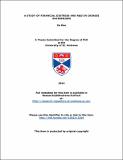A study of financial distress and R&D in Chinese enterprises
Abstract
Over the past 30 years, the Chinese economy has been going through complex
transformation from a centrally planned towards a market economy. The reform of the
enterprises has played an important part in this transformation. This is in addition to
macro economy reforms, as well as changes in the institutional framework.
The thesis examines the implications of macroeconomic, ownership structure,
as well as comprehensive institutional framework changes for Chinese enterprises’
survival and R&D activities.
I study the impact of both microeconomic factors and the macro economy on
the financial distress of Chinese listed companies over a period of massive economic
transition, 1995 to 2006. Using hazard regression analysis, I find substantial effects of
firm level covariates (age, size, cash flow and gearing) on financial distress, but also
significant roles for macroeconomic stability and institution effect. Business exits in
my data on Chinese quoted firms are vanishingly rare, arguably because of active state
protection for the failing firms. I investigate the firms’ innovation activity and efficiency of different ownership
sectors. Ownership influence on R&D investment and efficiency is estimated, using
productivity frontier function, for a sample of large and medium size Chinese industrial
enterprises from 2000-2007. I found that the presence of state ownership is positively
related to R&D investment, but negatively related to R&D performance. Foreign firms
are technical leaders in Chinese industries and have advantage in R&D efficiency. My
results also show significant cross industries differences in R&D effort and technical
level. These point out that firms possessing more innovation resources and government
support are not the ones performing better technically.
I extend my study into a more general mixed duopoly model in which a welfare maximizing public firm competes with profit maximizing private firm in R&D. I
assume that different operation strategy influence firms’ tolerance of R&D spillover
which plays a key role in their R&D investment mount and technology efficiency. I
prove that a public firm is more likely to share its R&D fruit and its higher R&D invest-
ment is accompanied by lower efficiency.
Overall, macroeconomy on firm survival and ownership structure on firm innovation activities are channels to understand Chinese economy reform. Because conditions in China were similar in many ways to other transition economies, these results
provide important information about the process of economic transformation more
generally.
Type
Thesis, PhD Doctor of Philosophy
Collections
Items in the St Andrews Research Repository are protected by copyright, with all rights reserved, unless otherwise indicated.

